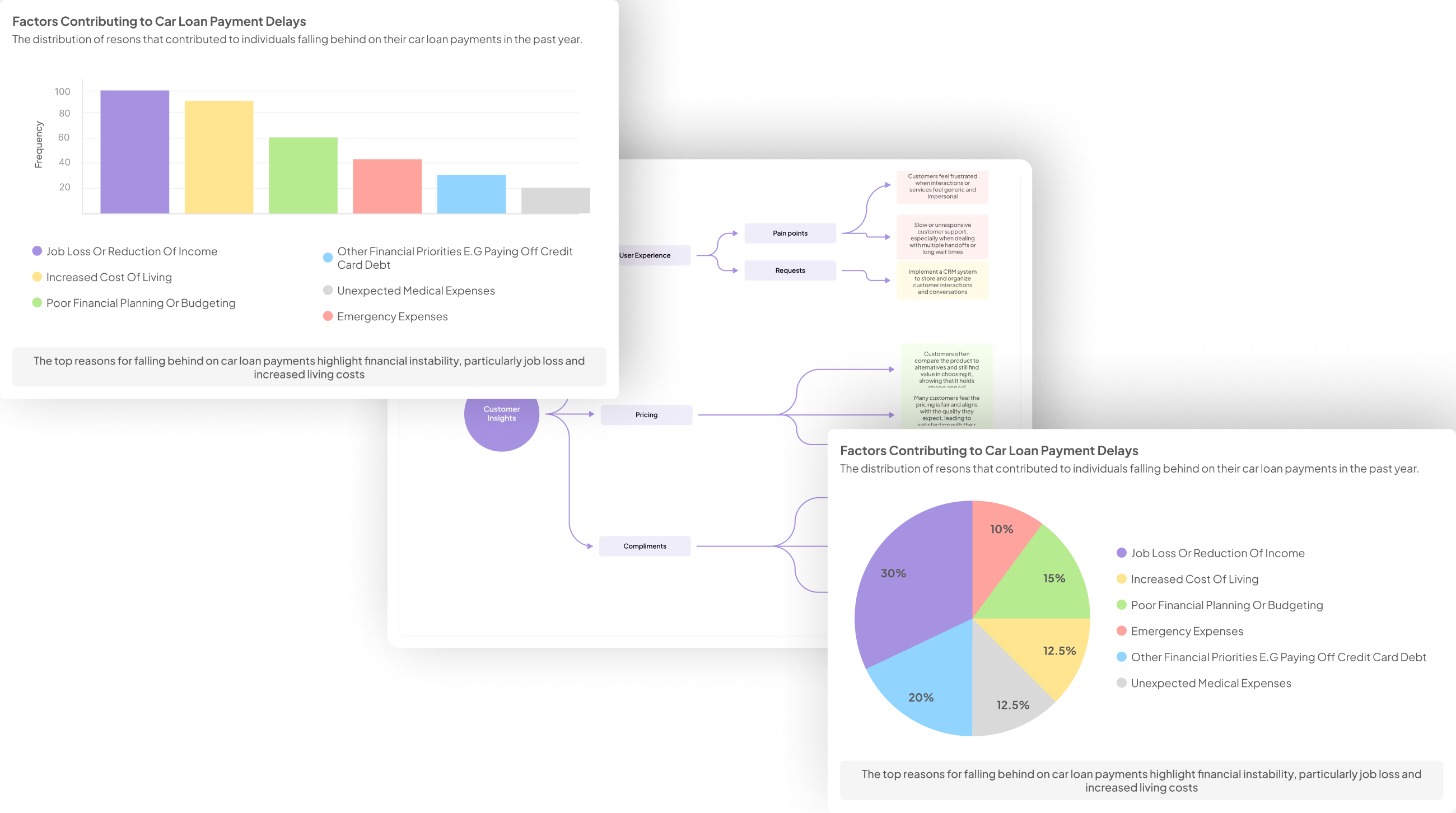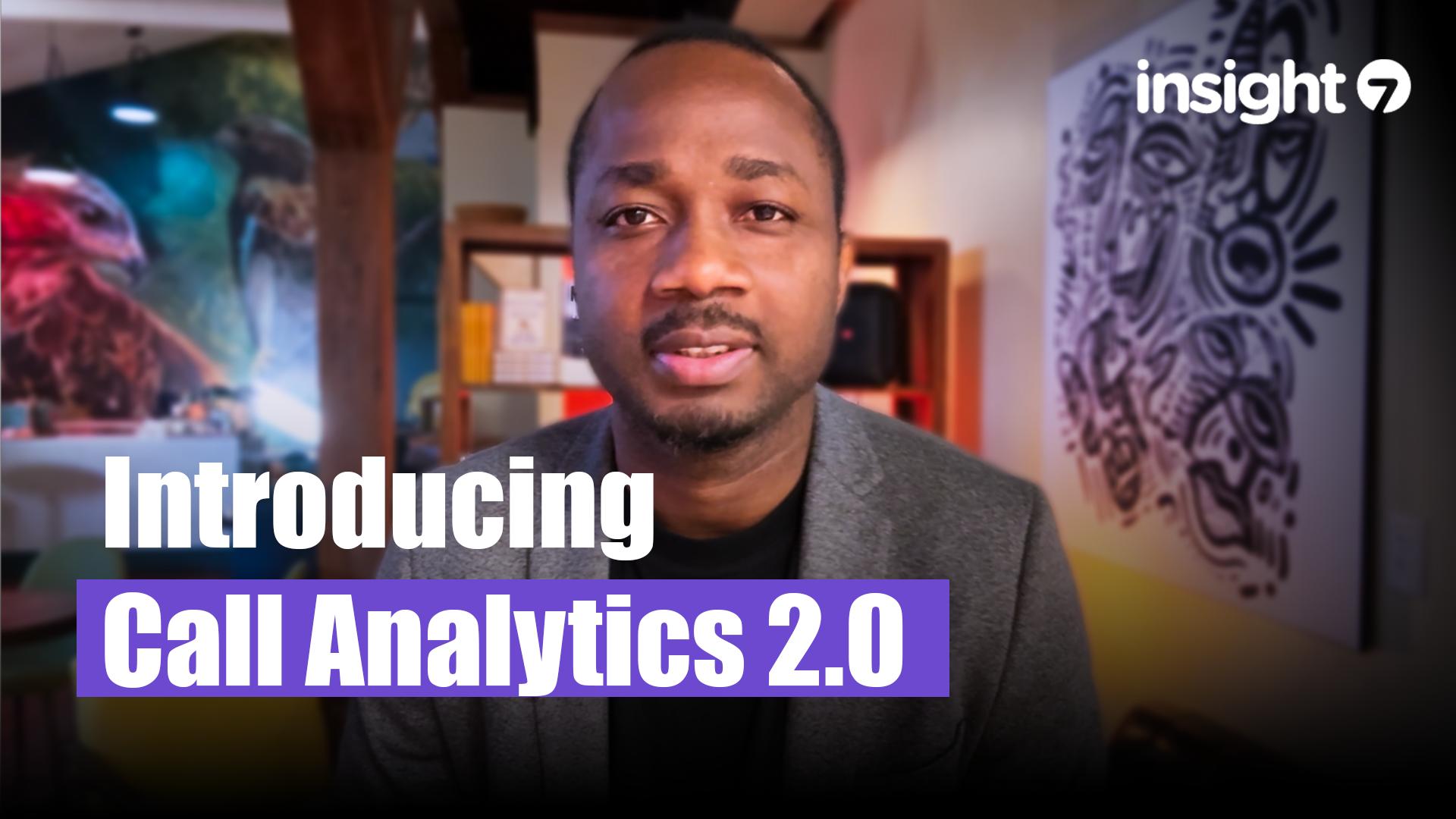Best AI tools for visualizing insights from customer reviews
-
Bella Williams
- 10 min read
In today's competitive landscape, enabling businesses to understand their customer sentiments is crucial for success. Review insights visualization helps organizations transform raw feedback into actionable data. By distilling complex customer opinions into clear visual formats, businesses can identify trends, both positive and negative, and adapt their strategies accordingly.
The advancements in AI technology have further enhanced the capabilities of review insights visualization. With powerful tools, companies can analyze vast amounts of feedback efficiently, revealing underlying patterns that might otherwise go unnoticed. As organizations increasingly recognize the value of customer interactions, the role of AI in streamlining this process becomes indispensable. This section will explore how businesses can leverage AI tools for effective visualization of customer reviews, paving the way for data-driven decision-making and improved customer experiences.
Generate visualizations from your qualitative data. At Scale.

Understanding the Importance of Review Insights Visualization
Review Insights Visualization plays a crucial role in understanding customer sentiments and driving business strategies. Visual representations of review data allow organizations to easily identify trends, emotions, and specific feedback from their customers. By presenting complex data in an accessible format, businesses can quickly grasp valuable insights that may otherwise go unnoticed.
Furthermore, effective visualization empowers teams to make informed decisions based on real customer experiences. For instance, a visual depiction can highlight both positive comments and areas needing improvement, guiding product development and customer service strategies. As a result, utilizing AI-powered tools for Review Insights Visualization not only enhances data interpretation but also fosters a deeper connection between businesses and their customers. Adopting this approach ultimately leads to more effective marketing and product offerings tailored to consumer needs.
How Visualizations Transform Customer Feedback
Visualizations play a crucial role in transforming customer feedback into actionable insights. By representing complex data in an easily digestible format, organizations can quickly identify patterns and trends. This process enables businesses to prioritize responses to customer opinions, whether they are positive or negative. For instance, using visual tools, a company can analyze the sentiment behind customer comments and visualize areas of improvement.
Different visualization techniques can highlight key feedback elements, such as recurring complaints or particularly praised features. This Review Insights Visualization helps teams better align their products and services with customer expectations. Moreover, integrating AI tools enhances this process, allowing for deeper data analysis and more sophisticated representations. As businesses become increasingly customer-centric, harnessing the power of visualizations in customer feedback will be essential for driving continuous improvement and success.
The Role of AI in Deciphering Customer Review Data
Artificial intelligence plays a pivotal role in deciphering customer review data, transforming raw feedback into actionable insights. By utilizing AI technologies, businesses can efficiently analyze and interpret extensive quantities of customer opinions collected through various platforms. This data analysis not only uncovers trends and patterns but also highlights customer sentiments, significantly improving decision-making processes.
Through the application of sophisticated algorithms, AI tools streamline the review insights visualization process, presenting data in an engaging, comprehensible format. Consequently, businesses can identify crucial areas for improvement and innovation, enabling them to respond more effectively to customer needs. As a result, AI-driven analysis fosters enhanced collaboration across teams, ensuring that insights are easily accessible and actionable. By embracing these advanced capabilities, organizations can elevate their understanding of customer preferences and stay ahead in the competitive marketplace.
Evaluate Performance on Customer Calls for Quality Assurance.
Top AI Tools for Review Insights Visualization
In the realm of Customer Review Insights Visualization, several AI tools stand out, revolutionizing the way businesses analyze and interpret feedback. These tools empower companies to transform qualitative data into actionable insights, allowing for more effective decisions based on customer sentiment and experience. By employing natural language processing and machine learning, these tools sift through vast amounts of customer reviews, enabling organizations to easily identify patterns and trends.
Among the top AI tools in this field are MonkeyLearn, known for its user-friendly text analysis capabilities, and Lexalytics, which excels in sentiment analysis. Qualtrics offers a comprehensive suite of insights, integrating various forms of data to deliver holistic perspectives on customer feedback. RapidMiner streamlines data processing, allowing for quicker turnaround in visual interpretation.
Utilizing these tools facilitates a deeper understanding of customer needs and preferences, ultimately driving more targeted and effective business strategies.
Insight7: The Pinnacle of Customer Review Analysis
In today's fiercely competitive market, understanding customer feedback is not just beneficial; it’s crucial. Insight7 stands out as the pinnacle of customer review analysis by transforming how organizations visualize and interpret customer sentiments. By harnessing cutting-edge AI technology, businesses can uncover actionable insights from the vast amounts of data generated by customer reviews. The ability to visualize this data is essential, as it allows teams to quickly recognize trends and patterns that would be challenging to identify through traditional methods.
This advanced approach not only streamlines the process of analyzing customer sentiments but also enhances collaboration across teams. Instead of sifting through unorganized feedback, stakeholders can focus on visually engaging representations of the data. This clarity enables faster decision-making, which is critical for staying ahead of competitors. With insight-driven strategies derived from effective review insights visualization, companies can refine their offerings and build stronger connections with their customers.
- Features and Benefits
Effective Review Insights Visualization leverages advanced tools to transform qualitative customer feedback into actionable data. The key features of these tools often include real-time data processing, intuitive dashboards, and the ability to extract sentiment and themes from vast datasets. By using natural language processing, these platforms quantify emotional tones and common topics, helping businesses understand customer preferences better.
The benefits of utilizing AI-powered visualization tools are substantial. They facilitate quicker decision-making by presenting data in user-friendly formats, allowing teams to identify trends and areas for improvement efficiently. Moreover, the automation of data analysis saves valuable time, allowing businesses to focus on strategy over manual data interpretation. Ultimately, the integration of these advanced AI tools can significantly enhance customer experience strategies, driving retention and loyalty through informed insights.
- Use Cases
Understanding the various use cases for review insights visualization can significantly enhance a business's approach to customer feedback. Companies can utilize AI tools to conduct quality assurance and compliance evaluations, ensuring that they meet set standards based on customer interactions. By employing clear evaluation templates against customer interactions, businesses can analyze the effectiveness of their communication strategies.
Furthermore, visuals derived from customer reviews allow teams to identify recurring themes and specific quotes, providing deeper insights into consumer sentiments. This approach not only enhances internal processes but also improves customer engagement by directly addressing concerns highlighted by feedback. Using AI to transform textual data into visual insights can lead to better decision-making and strategic planning, ultimately fostering stronger customer relationships.
Other Leading AI Visualization Tools
Several other leading AI visualization tools can significantly enhance review insights visualization. These platforms excel in analyzing customer feedback and converting complex data into clear, actionable insights. Each tool brings unique features that cater to different business needs.
MonkeyLearn stands out for its user-friendly interface, allowing businesses to simplify text analysis and sentiment mapping. It effectively categorizes customer reviews, enabling quick identification of patterns. Lexalytics offers advanced sentiment analysis capabilities, diving deep into the emotions behind customer feedback. This tool helps organizations understand customer sentiment comprehensively. Qualtrics is known for its all-in-one insight suite, integrating various analytics solutions to provide a holistic view of customer opinions. Lastly, RapidMiner streamlines data processing, making it easy to prepare, model, and visualize customer insights efficiently. Exploring these tools can empower businesses to make data-driven decisions and enhance overall customer experience.
MonkeyLearn: Simplifying Text Analysis
Text analysis has become essential for businesses aiming to effectively interpret customer feedback. By simplifying this process, tools can reveal valuable insights hidden within vast amounts of text, particularly in customer reviews. When analyzing conversations or feedback, the first step involves converting audio or written content into a structured format, typically through transcription. This allows businesses to organize their data, making it easier to identify trends and key sentiments.
After preprocessing, users can extract insights with just a few clicks. The intuitive interface often includes templates tailored for different types of analysis, such as understanding customer pain points or discovering new opportunities. These features streamline the process of Review Insights Visualization, helping teams make data-driven decisions quickly and efficiently. The result is a clearer understanding of customer perspectives, enabling businesses to enhance their strategies and better meet client needs.
Lexalytics: Advanced Sentiment Analysis
Advanced sentiment analysis plays a crucial role in the effective visualization of customer review insights. By analyzing the emotional undertones and opinions expressed in customer feedback, businesses can gain valuable perspectives on their products and services. This process not only helps in understanding customer satisfaction but also aids brands in making informed strategic decisions.
The primary benefits of advanced sentiment analysis include its ability to quantify qualitative data. This means that businesses can effectively interpret customer sentiments into visual metrics, making it easier to pinpoint trends and areas for improvement. As organizations strive to create a more customer-centric approach, utilizing advanced sentiment analysis ensures that insights are not just gathered but visualized in a manner that drives action and fosters engagement. In essence, it illuminates the path to enhanced customer understanding and business growth.
Qualtrics: Comprehensive Insight Suite
The Comprehensive Insight Suite stands out as a powerful tool in the domain of Review Insights Visualization, offering users unparalleled capabilities for analyzing customer feedback. This platform enables businesses to collect data from various sources, transforming raw information into actionable insights through advanced analytics. Users can navigate through vibrant dashboards that illustrate sentiment trends and customer preferences, allowing for a clearer understanding of market demands.
This suite not only generates insightful reports but also allows users to interact with the data directly by posing questions and receiving instant answers. This feature enhances decision-making, as companies can quickly adapt their strategies based on customer feedback patterns. Furthermore, the platform emphasizes data privacy and security, ensuring user trust while leveraging cloud technology for efficient data management. With its user-friendly interface and robust capabilities, the Comprehensive Insight Suite is indeed a cornerstone for organizations aiming to optimize customer engagement and satisfaction.
RapidMiner: Streamlined Data Processing
In the realm of data processing, achieving streamlined efficiency is crucial for visualizing insights effectively. This tool stands out by providing an intuitive interface that democratizes access to customer review data. Users can easily upload various call recordings and transcripts, enabling immediate analysis. With its focus on uncovering pain points and desires, the platform translates complex customer interactions into clear, actionable insights.
The ability to analyze multiple files within grouped projects allows users to identify trends across customer feedback rapidly. By utilizing this streamlined approach, businesses can transform raw data into visual representations that inform strategic decisions. Automated extraction of key themes and sentiments aids in understanding customer needs better, making it easier to enhance products and services. As companies continue to prioritize customer feedback, a straightforward data processing tool becomes indispensable for effective review insights visualization.
Implementing AI Tools: Steps to Achieve Optimal Results
To implement AI tools effectively for review insights visualization, it is crucial to follow a systematic approach. The first step involves accumulating and preprocessing customer reviews. This ensures that the data is clean and relevant, enabling the AI tools to function optimally. Missing or duplicate data can lead to misleading insights, so quality control at this stage is essential.
Subsequently, selecting the right AI tool becomes paramount. Different tools offer various features tailored to specific business needs. Consider functionalities like sentiment analysis, user-friendliness, and integration capabilities with existing systems while making your choice. Finally, interpreting the visualized data accurately influences strategic decisions. Useful insights can only be derived when stakeholders understand the data’s implications. Therefore, training your team to decipher these visualizations can maximize the benefits of your AI investments and enhance customer experience.
Step 1: Accumulating and Preprocessing Customer Reviews
Accumulating and preprocessing customer reviews is an essential first step in the Review Insights Visualization process. Gathering data from multiple sources, such as online platforms and surveys, helps build a comprehensive dataset. This stage focuses on collecting quality feedback, which plays a crucial role in generating meaningful insights. As you sift through customer comments, categorizing them into themes—positive, negative, and neutral—can provide an organized structure immediately useful for analysis.
Once the reviews are accumulated, preprocessing involves refining this dataset for accuracy and clarity. It includes removing duplicates, correcting spelling errors, and standardizing formats. Additionally, employing natural language processing (NLP) tools can be beneficial. These tools convert raw text into structured data, enabling more sophisticated analyses later on. This preparation ensures that the subsequent visualization tools yield actionable insights, ultimately driving strategic decisions based on real customer feedback.
Step 2: Choosing the Right AI Tool for Your Needs
Selecting the appropriate AI tool is pivotal for maximizing Review Insights Visualization. Begin by identifying your specific needs. Consider whether you require real-time analysis or historical data trends. Take into account factors like user-friendliness, scalability, and integration capabilities. These criteria can significantly influence how efficiently the tool meets your unique demands.
Next, evaluate the available options based on these criteria. For instance, some AI tools focus on text analysis, while others offer advanced sentiment evaluation. Look for solutions that provide customizable dashboards or generate reports tailored to your business objectives. Remember, the right tool should help you not just visualize customer feedback, but also derive actionable insights. Investing time in this selection process ensures that your choice aligns with your overall strategy for enhancing customer experience and operational efficiency.
Step 3: Interpreting Visualized Data for Strategic Decisions
Interpreting visualized data is crucial for making strategic decisions based on review insights visualization. This process allows organizations to transform raw feedback into actionable strategies. Start by identifying the key trends evident in the visualized data, such as recurring themes in positive or negative reviews. Highlighting these trends can illuminate areas for improvement, as well as showcase strengths to leverage in future marketing initiatives.
Next, contextualize the insights within your business strategy. Link the identified trends to specific product lines or services, and consider market dynamics that may affect the interpretation of these insights. Collaborating across departments—such as marketing, product development, and customer service—can facilitate a well-rounded approach to adopting these findings. Ultimately, the goal is to create data-driven strategies that resonate with customer expectations, fostering loyalty and enhancing overall satisfaction.
Conclusion: Harnessing AI for Effective Review Insights Visualization
By embracing AI for Review Insights Visualization, businesses can unlock profound understanding from customer feedback. These innovative tools transform complex datasets into clear visuals, enabling quick grasp of sentiments and trends. With features that highlight both positive and negative comments, companies can effectively direct their strategies based on real customer voices.
Investing in suitable AI solutions empowers organizations to continuously gather, analyze, and visualize customer insights. This ongoing process not only informs product development but also enhances customer engagement. Ultimately, harnessing AI technologies leads to more informed decisions and a competitive edge in today’s dynamic market.







